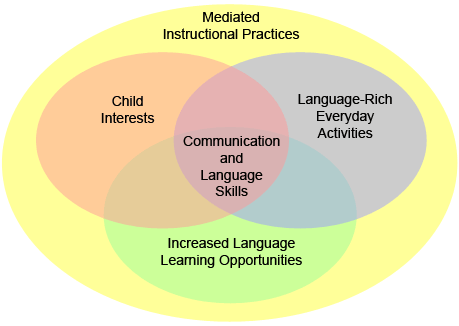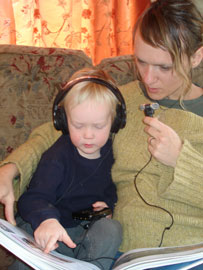


Welcome to the Center on Everyday Child Language Learning (CECLL). CECLL was a model demonstration center funded by the U.S. Department of Education, Office of Special Education Programs. The main goal of CECLL was to implement and evaluate an approach to early childhood communication intervention that used everyday activities as sources of learning opportunities to promote the development of the language and communcation skills of young children with disabilities and delays. CECLL was a major initiative of the Orelena Hawks Puckett Institute.
The Center of Everyday Child Language Learning worked with early intervention providers and practitioners in Delaware, North Carolina, and Tennessee to promote the use of child language learning practices and to evaluate the effectiveness of the practices. Practitioners and parents worked together to find the very best child language learning opportunities as part of everyday life.
The project model was designed to identify child interests, the everyday activities that are contexts of interest-based learning, increased child participation in interest-based activities, and caregivers� promotion of child communication and language development in the contexts of the everyday activities. A unique feature of the model is the use of children�s interests (likes, preferences, favorites, etc.) as a foundation for promoting their acquisition of functional and meaningful communication and language skills.

Everyday activities that make up family and community life that well suited for early communication and language learning. They include such things as dressing and undressing, eating meals, taking care of pets, rough housing, lap games, parent/child play episodes, eating out, neighborhood walks, library story time hours, play groups, feeding ducks or fish at the community pond, and so forth.
Child Interests include the likes, preferences, favorites, strengths, assets, etc. that motivate children to participate in desired activities that let them express their interests and abilities. Interests can be either personal or situational.
Communication and language skills include the non-verbal and verbal behaviors that young children use to communicate with others. Examples include vocalizations, gestures, facial expressions, verbalizations, words, and other forms of communication (e.g., sign language).
Language and communication development is enhanced if children have many opportunities to participate in different kinds of interest-based everyday activities. Child communication and language learning are increased both by participation in different kinds of interest-based everyday activity and by the number of learning opportunities they have within any one activity.
Mediated instructional practices involve using evidence-based responsive strategies to respond to children in ways that elicit children�s on-going engagement in everyday interest-based activities and that promote their communication and language learning.
|

Everyday Child Language Learning Reports include descriptions of the language learning intervention model used by Center for Everday Child Language Learning staff and reseach syntheses of studies of practices that are key features of the Center's intervention model. |
|||
 |
Caregiver-Mediated Everyday Child Language Learning Practices: I. Background and Foundations Caregiver-Mediated Everyday Child Language Learning Practices: II. Intervention Methods and Procedures |
||
| Everyday Child Language Tools include the methods and procedures practitioners and parents can use to implement the Center on Everyday Child Language Learning intervention model and practices. | |||
|
Step-by-Step Guide for Providing Young Children Everyday Language Learning Opportunities Checklist and Guidelines for Identifying Young Children's Interests
|
||